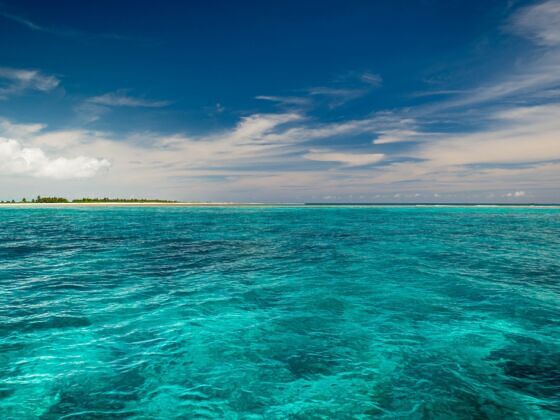WHEN YOU LOOK AT A MAP, Kiribati seems to be at the end of the world. From one of the nation’s largest islands, Kiritimati, it is well over 2,000 kilometers to the nearest international airport. With a population of 113,000 people and a landmass area totaling 717 square kilometers spread over 33 islands (for comparison, Manhattan’s land area is 87 square kilometers), Kiribati shows up as a set of tiny dots in a sea of blue on a tabletop map of the South Pacific.


A growing threat
These dots are in trouble. Due to rising sea levels, Kiribati is slowly sinking underwater, driving its citizens, led by president Anote Tong, to seek alternate spaces in which to live. Kiribati’s population is growing, with over 33% of i-Kiribati (as Kiribati’s citizens are known) under 14 years of age.1 Meanwhile, the ocean’s level is steadily rising. Furthermore, satellite readings published in Science may be pointing to an increase in the rate of this sea-level rise, suggesting that the pressure on Kiribati will correspondingly increase in the coming years.2
In response to this threat, President Tong has been in talks with the military government of Fiji to buy some of that nation’s land for his countrymen to move to. This idea is not unprecendented – recently, the low-lying island nation of the Maldives has discussed attempting to move to unoccupied land in Australia or Sri Lanka.3
President Tong has stated that he hopes that the eventuality will never occur, but meanwhile the rising ocean has already taken its toll. Kiribati is particularly vulnerable to the rising sea because the majority of the nation is only a few meters above sea level. In some locations, saltwater has contaminated Kiribati’s fragile freshwater supply, and one village has already been uprooted by rising water levels.4
Exploring solutions
The Fiji solution is the last in a series of efforts to combat the adverse effects of climate change on the island. Past efforts have included planting mangroves to protect the stability of coastal ecosystems, securing freshwater supplies, and starting construction on a seawall. However, Kiribati officials cite insufficient funds as an obstacle to building efficient seawalls.4
Last year, at the Pacific Islands Forum, the Kiribati government debated the possibility of moving some people to man-made ocean platforms similar to offshore oil rigs. At the podium, President Tong conceded that this was not an ideal option, but asked: “If you’re faced with the option of being submerged with your family, what would you do?” he asked. “Would you jump on the rig… on a floating island or not? I think the answer is yes.”4
While it considers the future, the Kiribati government also seeks to prepare its population for dramatic changes by helping its citizens acquire skills that would make them desirable immigrants to foreign countries. With its Education for Migration program, the Kiribati government aims to facilitate a gradual move to foreign shores beginning with a small amount of skilled laborers that would be in a position to provide a positive contribution to foreign economies.5 Kiribati’s success in implementing this plan remains to be seen, though over 800 students from Kiribati study at the University of the South Pacific, and this number has been increasing significantly in recent years.6
Dr Alumita Durulato, a USP lecturer in international affairs, commented: “They are already preparing quite well. They have educated their youth to be able to survive in the new lands that they want to go to. They are going to leave behind their culture, their way of life and lifestyle, which is a little bit different from ours in Fiji.”5
An unresolved future
The nation of Kiribati continues to weigh its options in the face of an uncertain future. Meanwhile, the country’s delegates, led by President Tong, continue to attempt to draw the international community’s attention to Kiribati’s situation. The UN Secretary-General, Ban Ki-moon, visited the island in 2011 and has since been a vocal advocate for action to assist Kiribati. In his speech to the Pacific Islands Forum, the Secretary stated that sea level rise is an effect of global climate change and spoke about the importance of addressing the situation.4
Several weeks ago, President Tong recently spoke about his country’s predicament at the 67th General Assembly of the United Nations:
Whether or not we are willing to acknowledge it, climate change and sea level rise are a result of the unsustainable use of our planet’s resources. Economic growth at all costs must not be our mantra, particularly when it is those who will benefit the least from this growth that will pay the ultimate price. The earth is not ours to do with as we please – we are merely trustees for future generations. We ignore this reality at our peril.7
Sources:
1. CIA World Fact Book
2. Nicholls, Robert J.; Cazenave, Anny (18 June 2010). “Sea-Level Sea-Level Rise and Its Impact on Coastal Zones”. Science Magazine 328 (5985): 1517–1520. Bibcode 2010Sci…328.1517N. doi:10.1126/science.1185782.
3. Maldivian Leaders Might Move the Entire Nation to Australia If Sea Keeps Rising
4. Sinking Pacific island Kiribati considers moving to a man-made alternative
5. Entire nation of Kiribati to be relocated over rising sea level threat
6. Kiribati, ADB Sign Loan for Upgrades to University of the South Pacific Campus
7. At UN debate, Kiribati’s President urges increased efforts to mitigate impact of rising seas